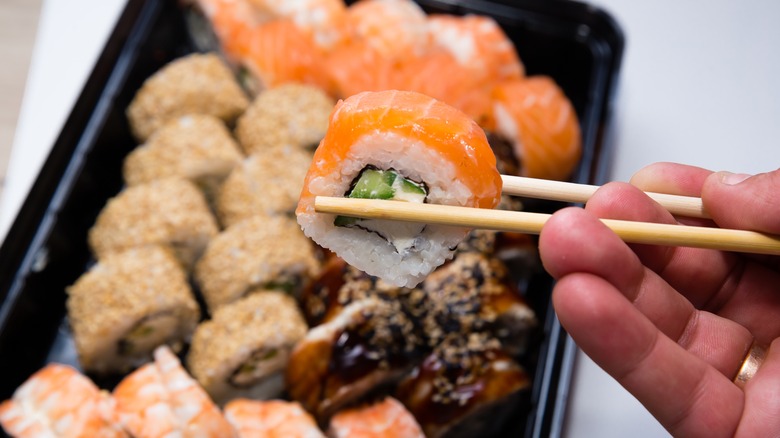How Long Leftover Sushi Actually Lasts In The Fridge
The only thing better than a delicious meal is the leftovers that follow. Leftover turkey can make for tons of tasty recipes like salads and sandwiches, and some of us even love a cold slice pizza for breakfast. Some delicious dishes just don't make for reliable leftovers, though, including sushi. Most types are made with vinegared rice, nori seaweed, and raw fish (or even different types of fish eggs). The raw seafood makes the shelf life of sushi awfully short, even if it's properly stored in the fridge.
According to the USDA, refrigerated raw fish and shellfish should be consumed within a day or two, or before 12 hours are up, if you'd like to err on the side of caution. Some types of sushi feature cooked seafood instead, or none at all, such as in cucumber rolls or tamago (omelet) nigiri. Sushi with cooked seafood or no seafood can last three to four days in the fridge. They could even keep for up to a week, but that's stretching it.
Even when safe to eat, week-old or even day-old sushi isn't the best. After a day in the fridge, you may find the rice in your sushi too dry, the seaweed lacking crispiness, and the vegetables mushy and discolored due to oxidization (especially avocado). To enjoy leftover sushi while it's safe to eat and relatively fresh, it's best to finish it within 24 hours.
How to store leftover sushi
Leftover sushi's shelf life depends on its ingredients, but storage is just as important. For one, it's paramount that sushi, like all refrigerated foods, be kept out of the USDA's "danger zone": a temperature range between 40 and 140 degrees Fahrenheit that makes foods extra hospitable to bacterial growth. Store sushi at or below 40 degrees Fahrenheit after wrapping it tightly in cling film or aluminum foil, or putting it in a sealed, airtight container.
The goal here is to minimize the sushi's exposure to open air, slowing the rate of oxidization and spoilage. You can keep leftover takeout sushi in its original box, as long as you cover the pieces in cling wrap. For extra protection, wrap a damp paper towel around the sushi, then wrap in cling film. This extra layer will prevent the moist rice and seafood from withering into dry morsels.
Lastly, sushi that has sat outside the fridge for too long should never be eaten. Any refrigerated food items left at room temperature for two hours or more should be thrown away, which is doubly true for raw fish. This window is lessened to an hour if it's a hot day, and the sushi has sat at temperatures above 90 degrees Fahrenheit. No amount of careful refrigeration can make spoiled sushi safe to eat.
Toss sushi out if you notice these signs
Because leftover sushi's lifespan is so delicate, closely inspecting its freshness before eating it is a must-do. Look for signs of mold or a foul smell, as well as discoloration or any changes in texture. While refrigeration will change the texture of the sushi, it should never be slimy, and the rice shouldn't be mushy and falling apart, nor dry and almost crunchy.
If the fish looks much more dull and pale in color than before, your leftovers are likely past the point of no return — these visual signs are red flags to watch out for when buying sushi, as well. If the seafood still looks vibrant in color, try pressing it with your fingers: It should feel springy but firm. Overly soft or soggy fish is a sign that the sushi is well past its prime.
You can tell a lot about sushi's freshness by its odor, as well. Fresh fish is supposed to have little to no scent. If you notice an overly fishy or sour smell wafting from the refrigerated leftovers, it's time to toss the sushi out. After all, the risks of eating spoiled sushi are far too grave to risk — it can lead to infections and food poisoning via harmful germs like salmonella. Try to enjoy sushi within a day of purchasing or making it, and when in doubt, throw it out.



